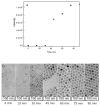Rose Bengal-Modified Upconverting Nanoparticles: Synthesis, Characterization, and Biological Evaluation
- PMID: 36143419
- PMCID: PMC9502678
- DOI: 10.3390/life12091383
Rose Bengal-Modified Upconverting Nanoparticles: Synthesis, Characterization, and Biological Evaluation
Abstract
High-quality upconverting NaYF4:Yb3+,Er3+ nanoparticles (UCNPs; 26 nm in diameter) based on lanthanides were synthesized by a high-temperature coprecipitation method. The particles were modified by bisphosphonate-terminated poly(ethylene glycol) (PEG) and Rose Bengal (RB) photosensitizer. The particles were thoroughly characterized using transmission electron microscopy, dynamic light scattering, thermogravimetric analysis, FTIR, and X-ray photoelectron and upconversion luminescence spectroscopy in terms of morphology, hydrodynamic size, composition, and energy transfer to the photosensitizer. Moreover, the singlet oxygen generation from RB-containing UCNPs was investigated using 9,10-diphenylanthracene probe under 980 nm excitation. The cytotoxicity of UCNPs before and after conjugation with RB was evaluated on highly sensitive rat mesenchymal stem cells (rMSCs) and significant differences were found. Correspondingly, consi-derable variations in viability were revealed between the irradiated and non-irradiated rat glioma cell line (C6) exposed to RB-conjugated UCNPs. While the viability of rMSCs was not affected by the presence of UCNPs themselves, the cancer C6 cells were killed after the irradiation at 980 nm due to the reactive oxygen species (ROS) production, thus suggesting the potential of RB-conjugated PEG-modified UCNPs for applications in photodynamic therapy of cancer.
Keywords: Rose Bengal; cytotoxicity; nanoparticles; photodynamic therapy; reactive oxygen species; upconverting.
Conflict of interest statement
The authors declare that the research was conducted in the absence of any commercial or financial relationships that could be construed as a potential conflict of interest.
Figures








References
-
- Freitag M., Möller N., Rühling A., Strassert C.A., Ravoo B.J., Glorius F. Photocatalysis in the dark: Near-infrared light driven photoredox catalysis by an upconversion nanoparticle/photocatalyst system. ChemPhotoChem. 2019;3:24–27. doi: 10.1002/cptc.201800212. - DOI
-
- Bünzli J.G., Eliseeva S.V. Lanthanide NIR luminescence for telecommunications, bioanalyses and solar energy conversion. J. Rare Earths. 2010;28:824–842. doi: 10.1016/S1002-0721(09)60208-8. - DOI
-
- Ansari A.A., Parchur A.K., Thorat N.D., Chend G. New advances in pre-clinical diagnostic imaging perspectives of functionalized upconversion nanoparticle-based nanomedicine, Coord. Chem. Rev. 2021;440:213971. doi: 10.1016/j.ccr.2021.213971. - DOI
Grants and funding
LinkOut - more resources
Full Text Sources

